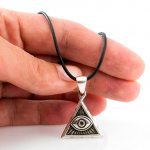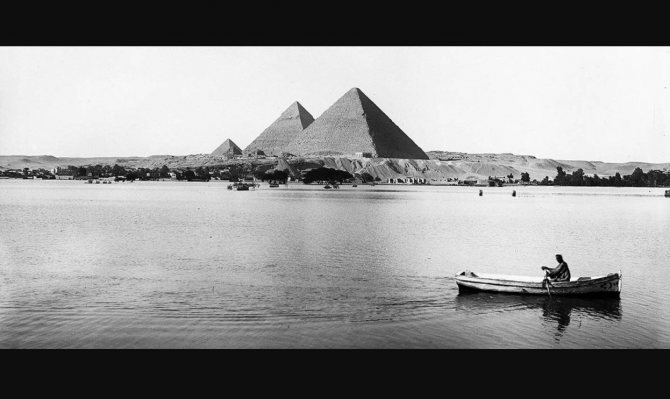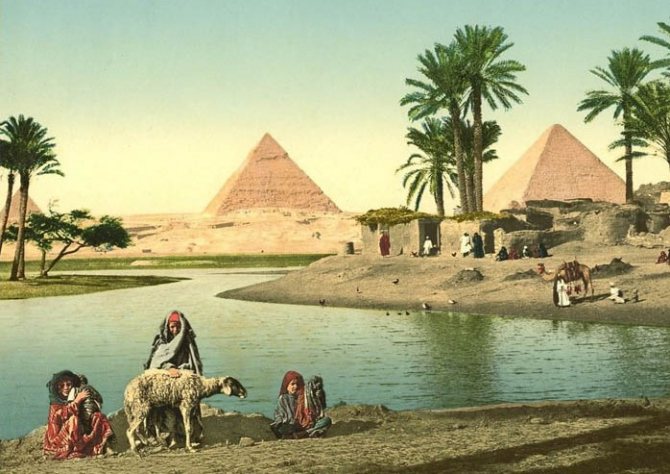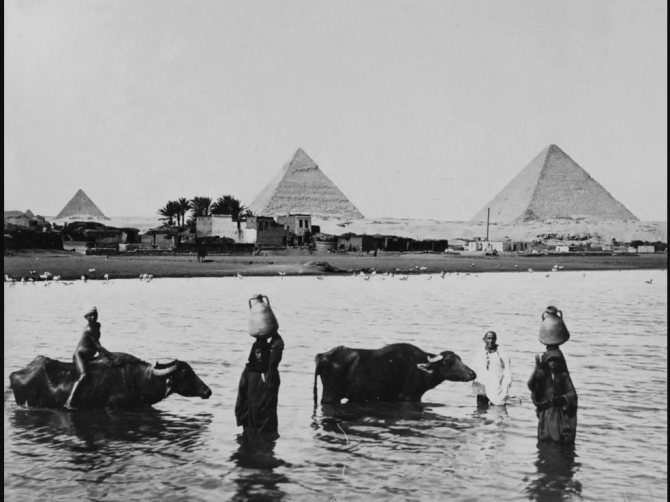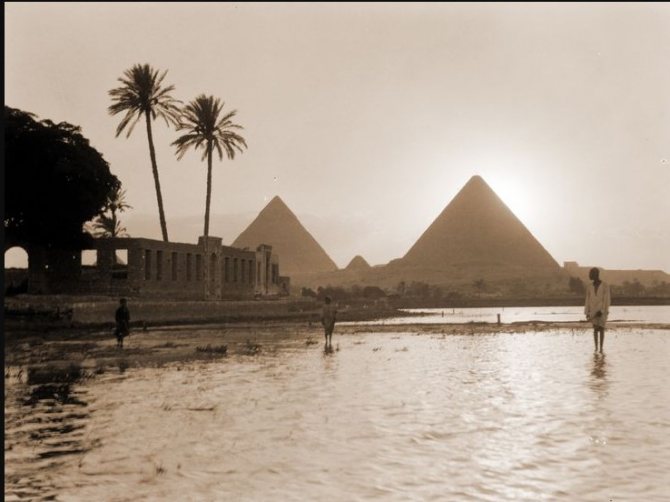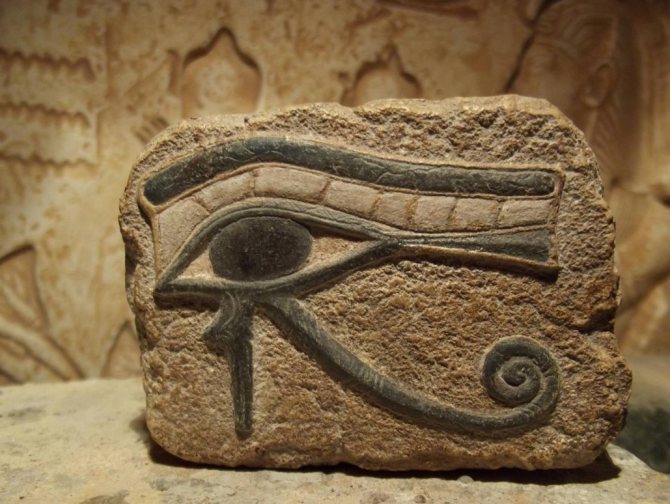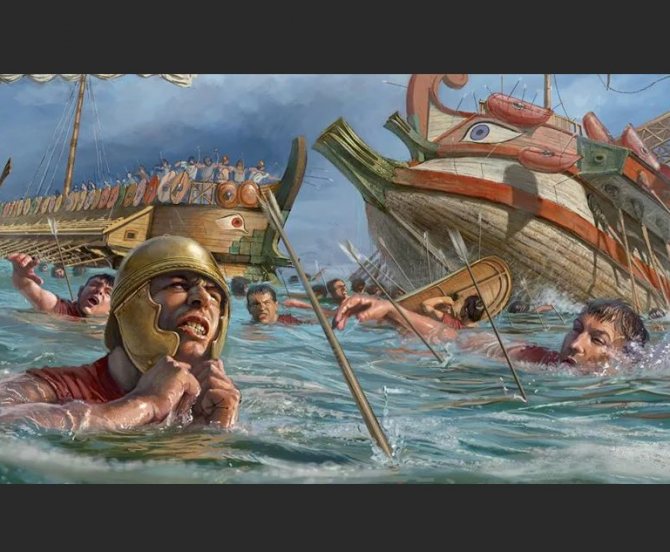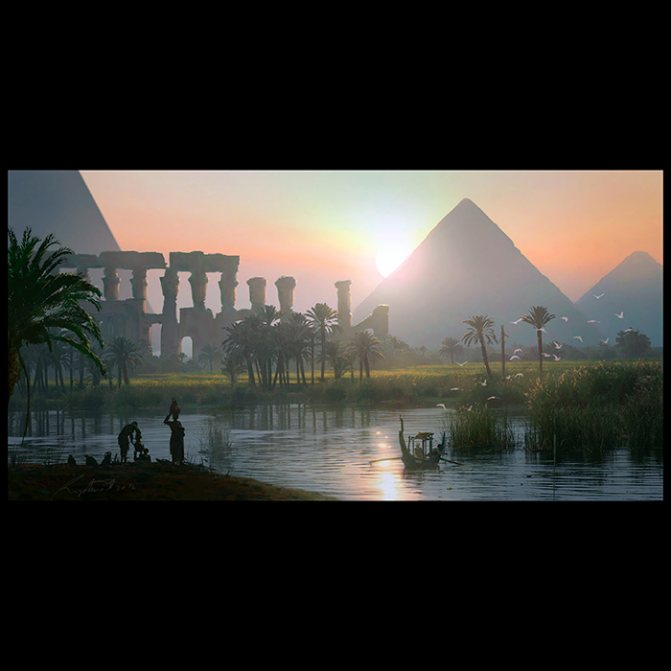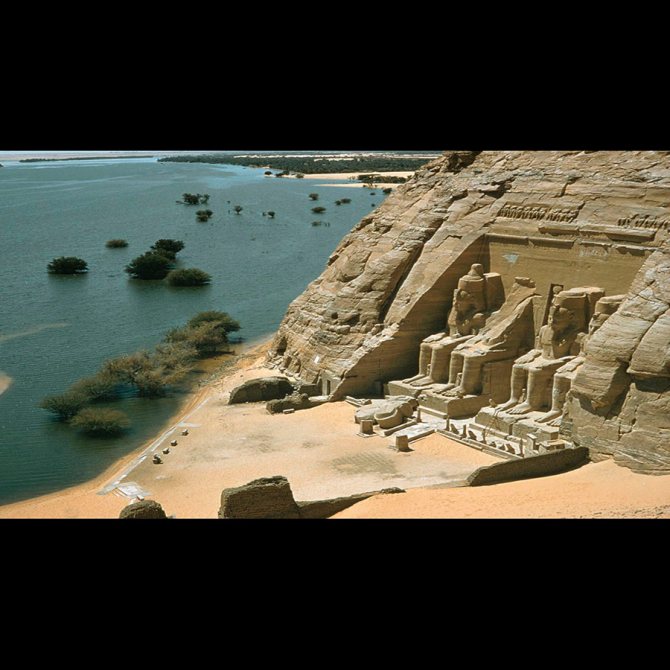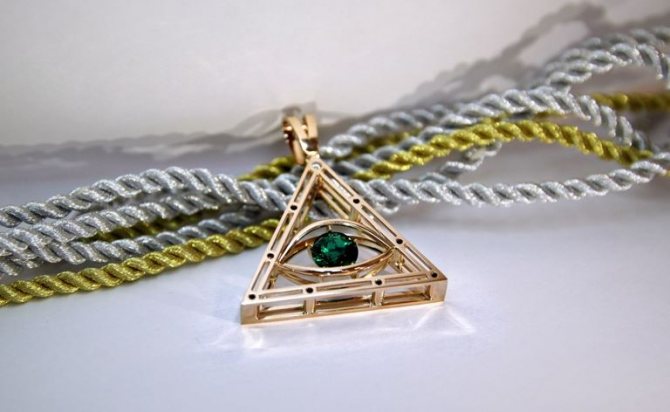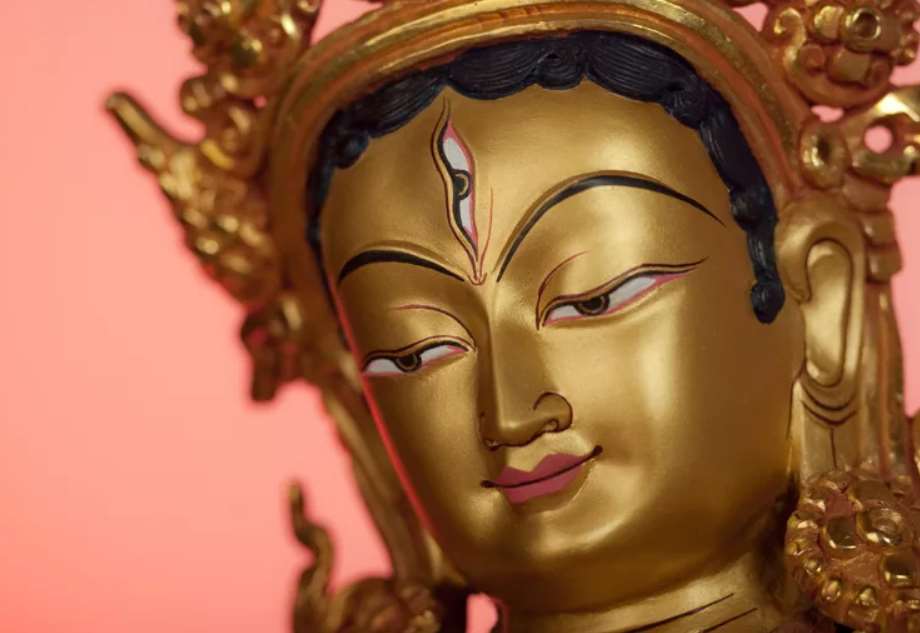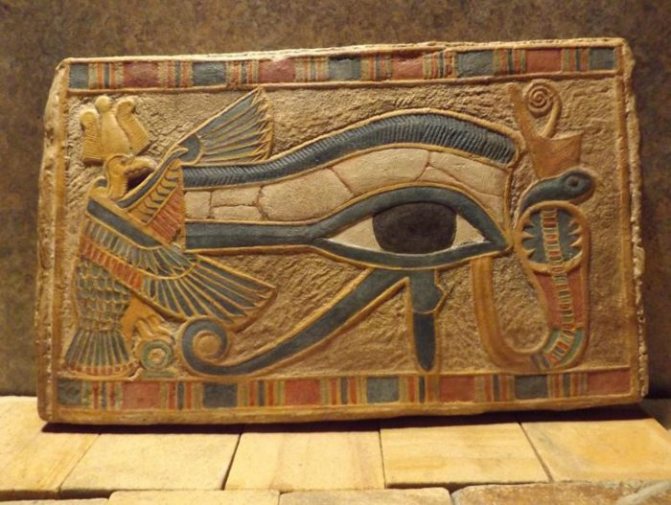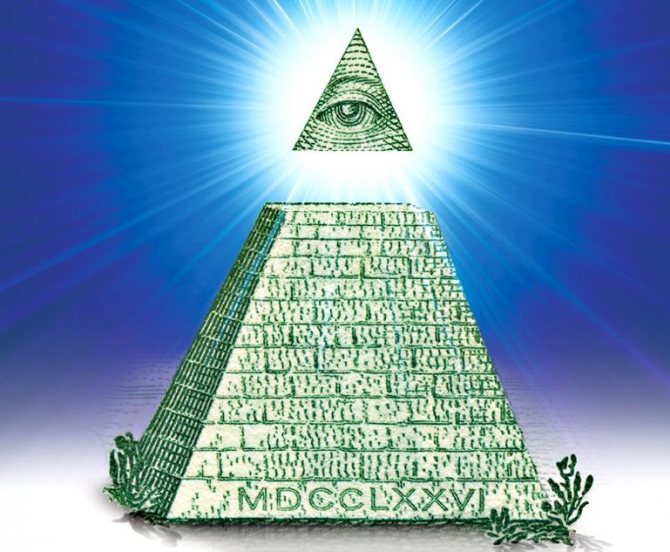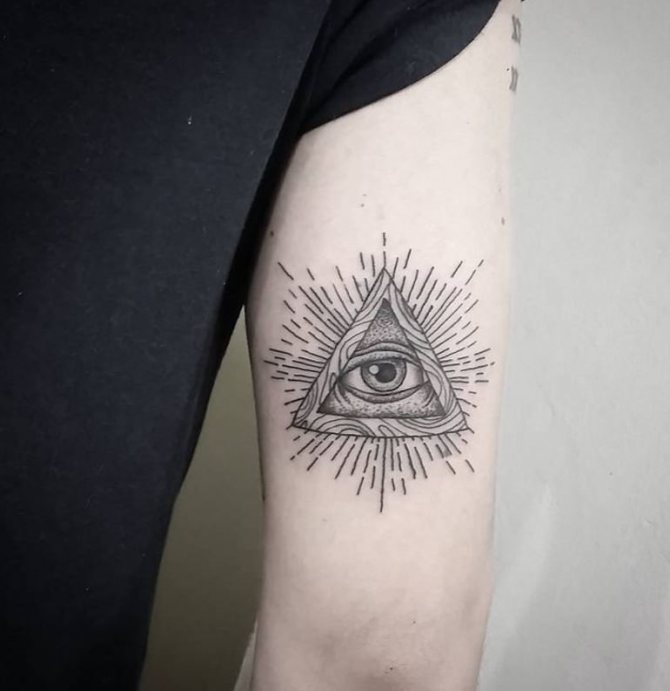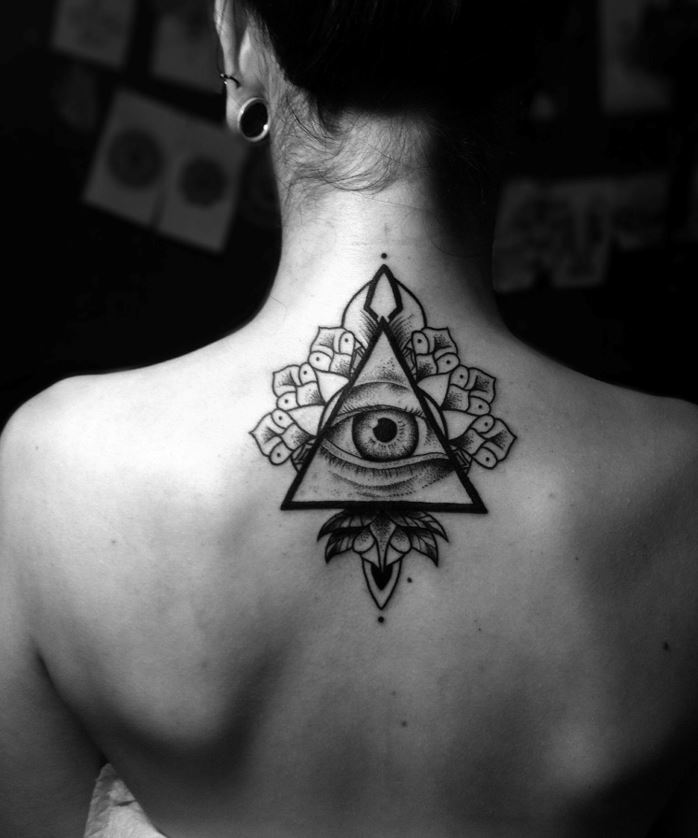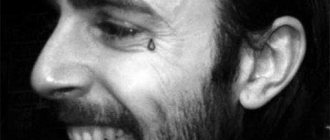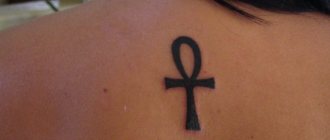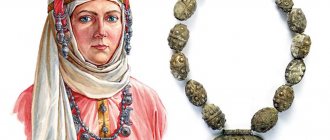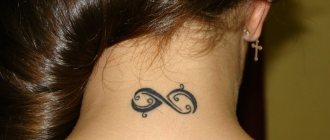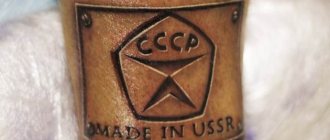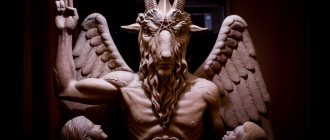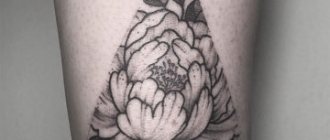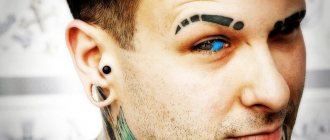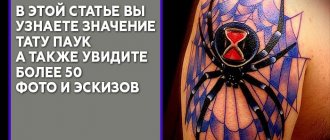The triangle with an eye inside is a popular and mysterious symbol found in many cultures. However, the scientific world is inclined to a theory that considers Egypt to be the first place where the All-Seeing Eye appeared.
The ancient Egyptians believed that this Egyptian sign symbolized a bright future, power and absolute authority. They also believed that it helped to heal people and opened a person's ability to clairvoyance.
Types of omniscient eye
In Japanese and Chinese tradition, the sign of the all-seeing eye is the image of the sun and moon, which symbolizes the past and future time.
The Indians of North America also used the eye in the triangle, which is the Eye of the Great Spirit. It is he who according to the American aborigines knows everything about the past, present and future.
Traditions of Hinduism interpret the symbol as the third eye of the god Shiva. At the same time, in Buddhism, the sign denotes the third eye of the Buddha. The symbol means wisdom and spiritual development.
Yogis of ancient times believed that thanks to this symbol, a person opens up knowledge about the future, the past and the present. In addition, in this Eastern culture, the sign is responsible for protection from evil forces and can symbolize vigilance.
In ancient Greek culture, the all-seeing eye was a symbol of Apollo and Zeus, and the eye itself within the triangle represented the sun. The symbol was a symbol of light, warmth and protection. The Celts considered the sign an eye of evil, which represents evil thoughts and human envy.
Christians consider the triangle with the eye inside an "eye of God" that brings light and power. The triangle surrounding the eye signifies the holy trinity, and the light around it is a divine blessing.
Masons consider this symbol a sign of clairvoyance as well as the Radiant Delta. It symbolizes sunlight, creation and higher intelligence. The Radiant Delta helps one find the right answers to life's questions, illuminating the path for the person seeking arcane knowledge.
New in Blogs
The All-Seeing Eye - In iconography, a complex symbolic-allegorical composition symbolizing the All-Seeing God. Appears in Russian iconography since the late 18th century as a dome image in temples: on top of the vault or some part of it.
This sign was most popular in the XVIII century, and reached its peak at the beginning of the XIX century, during the reign of Alexander I. During this period the icon of the All-Seeing Eye could be found both in the decoration of churches (for example, the Kazan Cathedral in St. Petersburg, the Ilyinskaya Church in Kiev) and in the civil sphere - pedestals of monuments, military medals, etc.
When European architecture has been actively used as a decorative motif "All-Seeing Eye" (and it began in the XVII century), it was thought that in this case uses some extraordinarily ancient, sanctified by tradition symbolism. This is strangely both true and untrue at the same time.
It is true because, indeed, the eye is found in the symbolism of many of the world's cultures, starting with the earliest ones. And it is quite natural to associate with the ocular symbol the idea of the Deity who sees everything. Not true - because no uninterrupted thousand-year tradition (as thought) of "all-seeing eyes" in European Baroque continued, rather asserting a new tradition with a contrived genealogy. Contrary to popular belief, the notorious All-Seeing Eye (an eye in a triangle surrounded by light) has nothing to do with either Kabbalah or Freemasonry. This symbol appears in late Renaissance emblematics and in this context it does not attract any particular attention: in the extensive guides to emblematics of the time (such as Andrea Alciati's Emblemata or Cesare Ripa's Iconology) one can find even more mystical images, to the modern eye. There is more scholastic abstraction than mysticism, and the iconographic language of this symbol is simple to the extreme: the equilateral triangle is the perfect triune Deity, the eye is the all-seeing Providence, and the radiance is unassailable glory. There is something specifically Renaissance, different from the medieval symbolism here. But this little is significant. We cannot doubt that the dissemination of this symbol was influenced by the discovery in 1419 of Horapollon's Hieroglyphics, an Egyptian writer of the late Roman syncretism era, who exalted the quite ordinary ancient hieroglyphs in the spirit of Alexandrian exegetics. Two hundred years later, when Father Athanasius Kircher took up the allegorical exegesis of ancient Egyptian culture, the fashion for Egyptian symbols becomes widespread. And the image of the eye, indeed, occurs frequently in these symbols.
In fact, in classical ancient Egyptian mythology, the "eye of Horus" ("Ujat" or "Ouajet") is a symbol of the resurrection of Osiris, which followed after Horus let his father swallow his own eye. But Kircher and his predecessors, inspired by Horapollo and Clement of Alexandria, saw in this ocean an expression of the Egyptians' high conceptions of the all-seeing Absolute. Everything then fell into a coherent system: if the Egyptians, according to the evasive interpretations of other Church Fathers, had comprehended or foreseen something very substantial concerning the Godhead, then it would be no shame for the Old Testament religion, the religion of the Father, to use some of the especially sacred Egyptian symbols. And if so, it follows that the undescribed and inexpressible essence of the Old Testament is very logically appropriate for its symbol to be the All-Seeing Eye, a composition that is emphasized in the abstract, almost non-figurative. It should be stressed that the sacralization of the Eye occurred quite late, at the time of the high Baroque, and even then this symbol continued to exist in the form of a secular emblem of Providence. And the context of its use corresponds to that of the emblem - we practically do not see it in painting, but we can see it in allegorical engravings, such as the "conclusions" of Peter the Great and post-Petrine times, where the Eye watchfully watches over the next victor or the succession to the throne collision. And, of course, in architecture - in church architecture in particular. And in this case, the appearance of the Eye suddenly turns out to be justified and logical to such an extent that, indeed, it seems as if this is what tradition has been going for and has been going for thousands of years. Strictly speaking, there are two of these cases. Above the portal (especially above the main entrance to the church) and above the main altar, as the completion of the altar composition. This is no longer just a concetto, not just an allegory. It turns out that a church building is not just a more or less harmonious combination of masses, volumes, and space; you cannot just walk in and out of it without coming into contact with it in some way. Volens-nolens you find yourself alone with the feeling that you are seen, that the architecture of God's visible house is endowed still with that unseeing omniscience which is inherent in the invisible Deity. Even if the Eye lurks among the stucco curls of the decor, it still evokes that sense of mysterious presence (and extends that sense to the architectural elements surrounding it). Firstly, among the whimsical late Baroque decor a strict triangle sooner or later catches the eye. And secondly, the architecture initially allocates to the All-Seeing Eye such a place that it just catches the eye, so that the viewer, if possible, inevitably comes into optical contact with the unblinking gaze of Providence.
When it is placed above a portal, it is not even necessary to think of particularly spectacular moves. The localization of the image above the entrance, marking in this way a particularly marked transition, a threshold - a motif as old as the architecture itself. In the case of Christian temples it is all the more natural. Another thing is that as time progressed the Eye more and more often moved upwards on the facade, to the pediment. No warrant theorists, neither ancient nor Renaissance, could ever have foreseen this, and none the less one must admit that few of the Christian symbols used in the 18th and 19th centuries were so ideally and harmoniously inscribed in the fronton decoration as the proverbial triangle with an eye surrounded by rays.
As for the altars, the whole interior of the temple came into play, concentrating all the viewer's attention on the main altar, i.e. all the various techniques (purely architectural, pictorial, illusionistic, scenographic) which were used in baroque architecture without the All-seeing Eye were used. The subtlety, however, is that the eye contact, if the Eye appears in the altar composition, is twofold. First, the viewer's gaze is directed to the throne and the tabernacle, that is, he himself, the viewer, saw the place where the Lord physically resides. And then - the natural movement of the praying person's gaze forward and slightly upward - and suddenly from the sculptural rays the divine gaze, penetrating the entire space of the church, is directed at the person. Which, because of the abstraction of the symbol itself, seems more vigilant, more meaningful and more intimate. This impresses not so much by its unexpectedness as by its elegant overturning of all the principles by which church interiors, especially baroque interiors, operate. Everything is constructed in accordance with the laws of optics, that is, it is servilely adapted to the way the human eye is arranged: symbols, allegories, moldings, columns, and chapels acquire in a sense a kind of mental comfort, if one understands that the impression they produce is based on otherworldly and quite material laws. Finally, here is the triumph of these regularities - the vanishing point that focuses the eye on the altar composition. And suddenly this vision, for which the entire space of the church works, is harshly reminded that there is also the Sight, which sees everything without any earthly optics.
There is a certain mystery to be found there. On the one hand, the symbol is strong and works very well in the conditions of the baroque church interior, fitting into the dialectical play of the visible and the perceptible peculiar to that time. On the other hand, it is a symbol with a secular genealogy and carrying little doctrinal, doctrinal meaning. Yes, trinitarianism, yes, all-seeing Providence-but for the seventeenth (and even more so for the eighteenth) century it is not enough. Not enough to be used decisively and universally in church art. The idea of the all-seeing Absolute in isolation had little value for the Counter-Reformation, for the propaganda of the exclusiveness of Catholic doctrine. With complete peace of mind this symbol could and has been used by Protestants and Orthodox, and even, scary to say, by deists. And since this symbol, as has been said, is of semi-secular origin, it could be perfectly used where architecture had to represent not only and not so much the centralized Catholic system of doctrine, as the religiosity of the state, which itself is in its own way the guardian of the interests of the all-seeing Absolute. It is no coincidence that, in the 18th century, the overwhelming majority of examples of the use of the All-seeing Eye in architecture were in countries associated not with the rabid supremacy of Rome, but with enlightened absolutism. In Austria, many provincial monasteries and churches are decorated with the image of the Eye (churches in Gmünden am Traunsee and Traunkirchen, the monastery of St. Florian in Linz, etc.), while in Gmünden, for example, the all-seeing Eye, along with the Habsburg coat of arms, is placed on the facade of the local judicial administration. This is France - a golden Eye between two kneeling angels adorns the altar of the new Royal Chapel in Versailles. Finally, Russia, where since the time of Peter the Great the notorious symbol has been used especially actively in architectural decoration.
Only at the very end of the 18th century, when the Eye predictably became a part of Masonic emblematics, Catherine II tried to veto its use in Orthodox architecture (it is interesting that it is the sovereign who makes the authoritative decision whether or not to give architectural works the symbol of the All-seeing Providence). She was more satisfied when instead of the eye in the same triangle was the Church Slavonic "BGЪ" under the title - an analogue of the symbol "Tetragrammaton in a triangle" that existed along with the Eye. However, during the Pavlovsk, Alexander and partly Nicholas times the Eye returned to the facades of Orthodox churches. These examples of Russian classicism are quite numerous; suffice it to recall at least the Kazan Cathedral by Voronikhin - a pediment with a gilded Eye decorates the main facade of the temple. And again, the same symbol appears not only in church architecture, but also in civil and even state emblematics. On the award medals dedicated to the victory of 1812, we see the All-seeing Eye, surrounded by the motto "Not to us, not to us, but to your name".
The creators of the new awards sought by means of medallic art to express and emphasize the idea, which was formulated in the manifesto, signed by Alexander I later - December 25, 1813 in Vilna:
"The sight of the destruction of his troops is incredible! One can hardly believe his own eyes. Who could have done it! We can say that what has been done is beyond human strength. Let us therefore recognize in this great work the Providence of God; let us cast ourselves down before His holy throne, and seeing clearly His hand, which has smitten pride and wickedness, instead of vanity and boasting about our victories, let us learn from this great and terrible example to be meek and humble doers of His laws and will."
"All-seeing eye" could not be better matched by a four-line inscription on the back of the medal: "NOT WE, - not we, - A NAME - YOUR". It is a truncated quotation from verse 9 of Psalm 113 of King David, and in full these words sound as follows: "Not us, O Lord, not us, but your name give glory, for your mercy, for your truth. Replacement of the portrait inscription was a remarkable fact, because until then on the Russian combat medals traditionally placed portrait or monogram of the emperor.
The first award of the new medal took place on August 30, 1813 during its consecration in the Trinity Cathedral of Alexander Nevsky Lavra. Among the awardees were the cavalry general A. P. Tormasov (former commander of the 3rd Western Army), Lieutenant General A. B. Fok (former chief of staff of a separate corps F. F. Steingel) and others. Awarding of medals in the army in force began in late 1813. The first medals were awarded to persons from the entourage and court staff of Emperor Alexander I, as well as to officers and officials of the Headquarters, who were then located in Frankfurt am Main. Then began the presentation of medals and in the regiments.
Myrtle Reading Room _ _ Awards for the Patriotic War of 1812
The disappearance of the All-Seeing Eye naturally coincides with the establishment of the ideology of "Orthodoxy, Autocracy, and Nationality" and with the emergence of the national style. In such circumstances, a symbol with such a past - a humanist-Jesuit invention, Catholic altars, Masonic use, and the emblem of an enlightened sovereign - could not, of course, survive. And in Europe, the venerable symbol from the beginning of the 18th century became somewhat marginalized, causing resentment among all adherents of conspiracy theories with its use among secret societies.
This completed the history of the spread of the All-Seeing Eye, which, as fate would have it, turned out to be the most common, most convenient and most polysemantic way of making an architectural work not only visible, but also, in a certain sense, sighted.Meanwhile, a truth unknown to late Renaissance iconologists is that in developing the iconography of the Eye, they were in fact joining a far more extensive tradition than they thought. Digging deeper, it turns out that at various times sacral building here and there is characteristic not only of abstract numinosity, but also of a sense of a supra-worldly Sight, from which it is impossible to hide precisely because it exceeds human notions of the hidden and visible.
In the Orthodox East already in the late Byzantine art appears the iconographic subject of the Eye of the Savior, which expresses, strictly speaking, the same idea of the all-seeing (and all-seeing) Providence as the eye in the triangle, but only with a much more complex language. Let me remind you: this is the image of the little Christ resting in the Garden of Eden with open eyes, facing the Mother of God and an angel with the instruments of the Passion. And this composition - like the European Eye - in the Greek tradition was often placed above the portal of the temple.And even further, in Nepal and Tibet, from a much older time the image of the eye was decorated with the top of the stupas: four eyes on the four sides of the world - it means all-seeing. So to this day these stupas and look in all directions, and it seems that they do not want to know about neither Kircher, nor about Horapollo, nor about Freemasons, nor about Catherine II. And that neither ideology, nor tradition, nor the history of architecture help them hide from the absolute gaze.
Sergey Khodnev Pattern - The All-Seeing Eye XI-MMIV - 15.07.2004
Later it changed from a domed image to an image made on an icon board, like an icon. The image penetrated from Catholic iconography and is non-canonical. The dogmatic basis for such an image is the words, "Behold, the eye of the Lord is upon those who fear Him and trust in His mercy" (Psalm 32:18).
This is one of the most complex symbolic iconographic compositions: the Lord is likened to the sun as a source of light, and the way of divine guidance to the eye.
Russian scholar Alexander Vinogradov wrote of the icon of the All-Seeing Eye of God: "The depiction of the double human face in the form of four or two eyes, one nose and lips undoubtedly indicates the close convergence of the elemental sun and the Spiritual sun - Jesus Christ the God-Man, in both together macrocosm and microcosm, for man is the small image of the great image - the world".
The symbolic face is surrounded by the figures of the four evangelists: these are the four elements, the four cardinal points, and - if you like - the four human temperaments. Well, the starry sky, against which Christ is depicted, needs no interpretation: it is the "Sky of Heaven", the kingdom of goodness, truth and beauty.
The icon expresses the idea of the Lord's omniscience, who is likened to the sun as the source of light, and the way of divine guidance to our highest organ, the eye.
The icon depicts a circle, concentrically composed of three or four circles:
Circle oneThe central one, with four rays radiating out from it, ending behind the great circle with the images of the Evangelists or their symbols.
The second circle The second circle represents, as it were, the face of a man, on which are placed four eyes, a nose and a mouth. The inscription on the circle reads: "My soul magnifies the Lord, and my spirit rejoices in the Lord my Savior.
Above the second circle is depicted with outstretched arms of the Virgin.
И Third circle intersected by many dense rays emanating from the center of the main one - the Sun of Truth-Jesus Christ, to the right and to the left of whom it is written: "My eyes on the faithful earth to plant and with myself. The inscription on the circle reads: "Isaiah's charcoal, manifesting the sun from the virgin womb, shining in the darkness, giving enlightenment to those lost in prudence.
The fourth circleThe largest circle depicts the starry sky with three seraphim and the inscription: "Seraphim is the word of God", or in this circle four angels, of which two are below with scrolls.
Crowning the entire icon is a circleThe circle, truncated at the bottom, in which the sky of heaven is embodied, with three seraphim in it, surrounding the Lord of hosts, blessing with both hands; the Holy Spirit, coming from Him, descends in the form of a dove on the head of the Mother of God. The figure of God the Father at the bottom is partially covered and surrounded by a halo, on the edges of which is inscribed: "God from heaven bestows His radiance on me". The entire circumference of the fourth circle bears the inscription: "Holy, holy, holy is the Lord of hosts; fill heaven and earth with your glory. The Lord, surrounded by clouds, sits on a rainbow, with a seraphim with outstretched wings at his foot; the Holy Spirit in the form of a dove is on the Lord's fingers.
On the corners - four circles of the Evangelists, from the third circle - for the fourth; on the circles - names and interpretation: Matthew wrote angel, ambassador of the Lord; Marko wrote eagle, flying to heaven; Luke wrote Telchim, Peace; John wrote lion, laid in the tomb.
AlsoThe All-Seeing Eye may be a symbolic image of the "All-Seeing Eye of God" inscribed in a triangle - not a canonical symbol of the Trinity.
Later Freemasons used this symbol to recall the all-seeing eye of divine providence, the presence of the Great Architect of the Universe in all the works of Freemasonry. The symbol is present in the decor of almost every Masonic lodge.
As for the Masons, they adopted their symbol from the Illuminati, which in turn appeared only in the 2nd half of the 18th century.
Their image is slightly different and is located above the truncated pyramid.
Here is what the notorious Dan Brown says:
"Eye in a triangle" - this symbol is called trinacria and is depicted on the emblems of Masonic lodges all over the world. It is the symbol of the Illuminati. Members of the fraternity call it the "shining delta," a Call to constant change and enlightenment. The eye refers to the Illuminati's ability to penetrate the essence of things, and the triangle refers to the letter of the Greek alphabet "delta".
Note: It probably refers to Triquetra (also triquetra, triqueter, from the Latin triquetrum - tri, three and quetrus, having corners) - a rather interesting symbol, whose origin and contemporary use is strikingly different. So, for example, after the tenth century in Russia symbolizpolzuvali mainly as a specific "varyazhskogo" ornamental motif. Today around the world the symbol is associated primarily with the understanding of the Trinity in Christianity. Because. Trinacria (also triskel, triskel, triskele, from the Greek. The symbol is found in the Greeks, the Macedonians, the Etruscans, the Celts, as well as (in a slightly different form) in the ancient Japanese[Which] and in the Himalayan peoples. The symbol is found in the Greeks, the Cretan-Macedonians, the Etruscans, the Celts, as well as (in a slightly different form) the ancient Japanese[What?] and the peoples of the Himalayas. In particular, it was the coat of arms of the noble and powerful Athenian house of Alkmaeonides. One of the first solar symbols, close in this respect to the swastika (sometimes triskelion is called triple, triangular or three-pointed, three-beam swastika). In addition, as a symbol of the movement of the sun, showing its three main positions - sunrise, zenith and sunset, the triskelion is close to the triquetra. Later the symbol represented the "run of time", the course of history and the rotation of the luminaries.
It is commonly written that the Illuminati's all-seeing eye is the the eye of Horus......or... the eye of Lucifer. (but it's depicted as an eye in a downward triangle).
So it has nothing to do with Christian symbolism.
Ouajet (also the eye of Ra or the eye of Horus) is an ancient Egyptian symbol, the left falcon's eye of the god Horus, which was knocked out in his fight with Seth. Horus' right eye symbolized the sun and his left eye symbolized the moon; its damage explained the phases of the moon. This eye, healed by the god Thoth, became a powerful amulet worn by many Egyptians - both pharaohs and commoners. It embodied various aspects of the divine world order, from royal power to fertility.
"The fate of the "All-Seeing Eye of God" icon in the Russian Orthodox Church is not an easy one. Patriarch Nikon in the 17th century fought against such images as non-canonical. Indeed, the drawing of the icon resembles a graphic image for eastern meditation, the so-called "mandala. In modern spiritual practice, this image is enjoyed by various gnostics and occultists. A large number of references on the Internet relating to this title refer to magic, the development of psychic abilities, and similar miracles. Unfortunately, once emerged, non-canonical icons continue to be reproduced with surprising persistence and consistency. This is true, for example, of the icon of the Old Testament Trinity, banned as early as the One hundred heads council. However, to this day its images are published in mass quantities and are present in Orthodox churches. I do not recommend that you place the icon of the "All-Seeing Eye of God" in the center of your spiritual and prayer life." - Rev. Dmitry Saveliev
"One may have different attitudes toward this non-canonical image, but remembering the qualities of God, it often comes to mind as a reflection of his omniscience, for 'the eye of the Lord is over those who fear him and trust in his mercy.'" - Christine Gogorian
The meaning of the eye symbol in the triangle
It is generally believed that the all-seeing eye represents the power that hides in knowledge. Thanks to it and its hidden power, a person can acquire the ability to know the hidden secrets of the universe. Thanks to this sign, you can rise above everyday life and acquire absolute power over people's minds.
According to some esotericists, the "All-seeing Eye" is the very third eye that helps open the human mind to hidden secrets. According to ancient lore, this symbol can help unravel universal mysteries and gain unseen spiritual and mental power.
Charms with a cat's or tiger's eye
The tiger's eye stone got its name because of its shimmering colors that resemble the eyes of a wild predator. The association with a powerful animal endows such an amulet with no less powerful properties. For example, such amulet will help to cope with insomnia or nightmares at night, is responsible for the prevention of disease and even cures psoriasis - if the owner of the amulet puts it on the painful area. In the past, Tiger Eye was given to jealous people - it helped them fight unreasonable attacks. And also amulet helped warriors and people who found themselves in dangerous circumstances - it was believed that the stone would strengthen intuition in a critical moment and help escape from bad events.
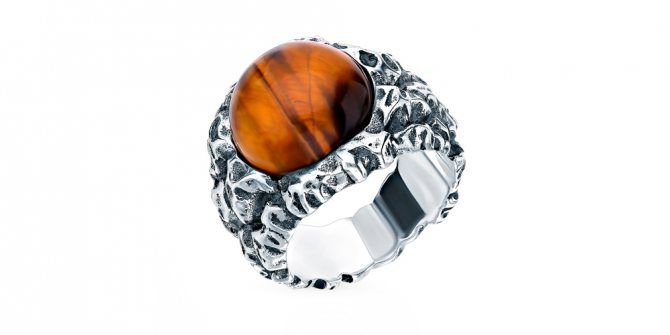
Silver ring with tiger's eye (watch in the SUNLIGHT catalog)
The cat's eye talisman differs from the tiger's eye mascot in color - the latter has emerald, lettuce shimmers instead of brown-red. Cats associate with dexterity, cunning and grace, perhaps that is why a talisman resembling a cat's-eye is advised to those who need help in love affairs. Cat's eye will add attractiveness to the owner, sympathy of other people and even help to strengthen existing relationships with a partner. Also, the talisman is endowed with the ability to avoid financial losses, so you can give it to an acquaintance of a spender or a person who is often unlucky in this sense.
Of course, you cannot let everything go and trust some talisman, but if you believe in their power, why not strengthen your position? Don't forget to tell us if any of these talismans helps you!
Author: Victoria Krestovskaya
Where did the "all-seeing eye" sign on the dollar?
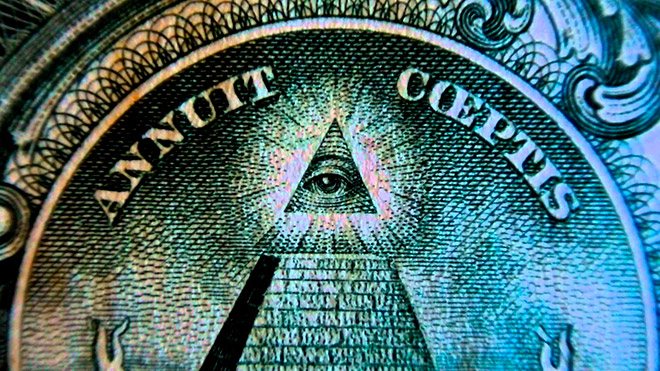

Probably the most mysterious symbol on the U.S. dollar is a pyramid with an all-seeing eye. If the official version is to be believed, this sign carries the meaning of power and knowledge, which should help the new American state to prosper.
On the pyramid itself there are 13 steps, representing the number of colonies that belonged to the United States. The unfinished pyramid means that the state is still in a state of development and it has serious undiscovered potential.
According to some researchers, all this symbolism means that the founders of the United States tried to change the world by building it on the basic principles of Christian morality. Based on this factor, we can conclude that America itself proclaimed the creator of the new world order.
Although there is a widespread belief that the sign of the "All-Seeing Eye" was placed on the dollar bill by the Masons in reality, there is no real evidence that this is a Masonic sign or that the Illuminati have anything to do with it. As the creators of the dollar design themselves say, this green triangle with an eye signifies God watching and guarding the new developing nation.
History of the origin of the Eye of All-Seeing
There is a theory that the Masonic eye or, as it is also called, the Radiant Delta appeared more than 6 thousand years ago. And the sign had two basic variants:
- The divine eye in an equilateral triangle. From him the rays diverge in different directions. This Egyptian symbol is called the Eye of Horus.
- The eye on top of the triangle.
The main meaning of the All-Seeing Eye is to protect against mental and physical illness. It also has healing properties.
According to other sources, the amulet provides the development of supernatural abilities, helps reveal lies and attracts positive energy.
The symbol also allows you to discover the inner world, to determine one's purpose and manifest strength of character. With its help, it is possible to go to the goal without abandoning their decisions.


Most often, a sign placed inside an equilateral triangle.
Talismans and amulets with "All-Seeing Eye"
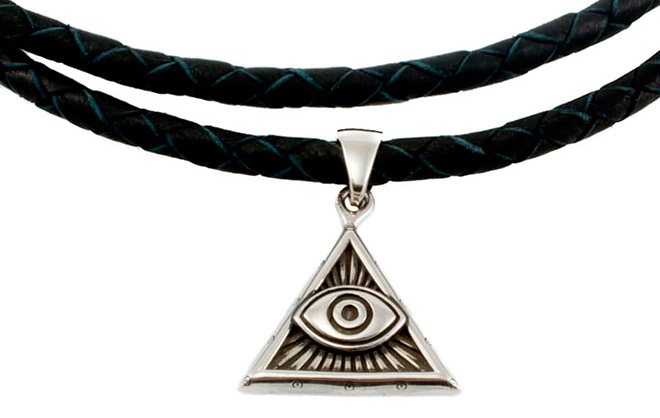

Many civilizations used an amulet with an eye. For such amulets used a variety of options for the drawing, as well as materials. In the main, all this directly depended on certain cultural features, and also on the climate where a particular nation lived. Often such talismans were used as a personal body talisman.
For the protection of your home and people living in it, this sign is not the best suited, although some people use it in that capacity. In some cases, such amulets can be placed even in offices. To achieve their goals, a sign can be placed in such a way that it looks at the object to which the person seeks.
In the case where the symbol should help people achieve career growth, it can be placed directly on the desk next to the office utensils. To improve one's financial situation, a coin depicting an eye in a triangle is often used.
The pendant with the "All-Seeing Eye" can be made from a variety of natural and artificial materials. For this purpose, absolutely any material is suitable. In the role of amulet can be not only a pendant, ring or bracelet, for personal protection, you can even use a piece of paper with a sketch of a drawing, which should always keep with you.
In general, regardless of religious preferences, this symbol can be used by anyone. This talisman actually has no expressed negative meanings and properties.
Use the Eye of All-Seeing Symbol correctly
According to the ancient teachings, the All-Seeing Eye can be used as the strongest amulet or talisman. It was created by ancient peoples for this very purpose.
Nowadays, the sacred symbol is applied on many products. It is still used to this day as an amulet for protection against trouble.
It is believed that the talisman:
- attracts goodness;
- It promotes the development of the intellect;
- reveals a person's supernatural abilities.
A green triangle is used in the design of banknotes. It can often be seen on coins, rings, pendants. And the image can be different. However, the main pattern usually includes a pyramid and the All-seeing Eye.
Talisman can be made of any material. A good choice is wood, fabric, metal. Also the image can be put on ordinary paper.
When choosing a variant of the picture should be clearly aware of what exactly will cause associations amulet. It is desirable to give preference to a particular image, taking into account the characteristics of this or that culture.


It is better to put the all-seeing eye on a natural material
Averters can be used to protect your home, livestock, and property. They are also used as individual talismans for people.
Such products are recommended to wear on the body. Many people get tattoos with the image of the eye. They are placed in their homes, cars, and workplaces.
In the opinion of esoterics, correct use of a talisman allows people to achieve success in work and in life. The symbol helps to keep and multiply your fortune and attract the right people in your life.
With such a patron will be able to gain wisdom, knowledge and talents. In addition, the amulet helps to reveal the unique abilities that are not typical of other people.
As an individual amulet symbol gives an effect only when worn on the body. Amulet can be embroidered on clothing or portrayed on a pendant. Thanks to this it is possible to achieve protection against complex diseases, spoilage, evil eye, curses. Also symbol protects its owner from injury.
As a personal amulet can be used spectacle agate. This stone is also called the eye of the Creator. It should be worn by Cancer, Libra, Taurus, Aquarius. As a talisman, you should use a gallstone with a yellow spot. A stone ring or other jewelry with an inlay will also benefit. Agate can be applied with you. Before going to sleep, it is recommended to put it under the pillow.
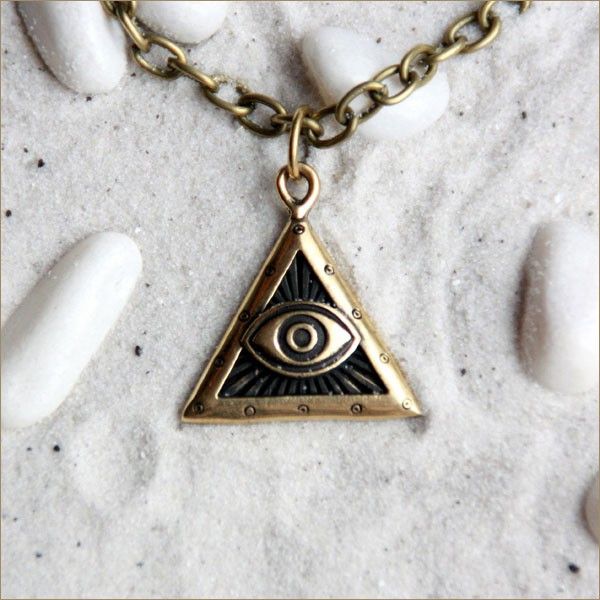

Amulet with an image of the symbol has unique magical properties.
Tattoos with "All-Seeing Eye"
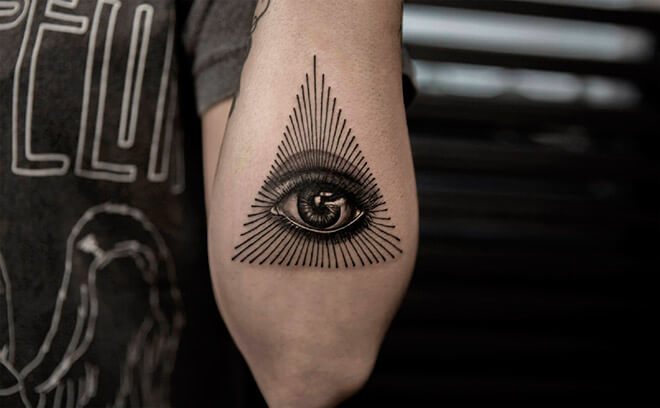

If as a tattoo will be used drawing of an eye inside a triangle, it will denote the divine eye, watching over a person. In ancient times tattoos were not as widespread as they are now, so previously no one attached any serious importance to them. In Western countries, a tattoo of the right eye represents the future and daylight. The left, on the other hand, represents night and the past. In Eastern cultures, the meaning of such drawings is exactly the opposite.
A person who wants to draw a similar ancient symbol on his body must be aware of its real energetic power. The main purpose of the talisman is to create a symbol of the Spirit of God, which is a symbol of the Spirit of God and of the Spirit of God.
This is a symbol of the "All-Seeing" and the "All-Seeing", which is a symbol of the power and wisdom of the human body, and a sign of the "all-seeing" and the "all-seeing". This sign allows the person to acquire additional strength and wisdom, which gives him the opportunity to do previously unimaginable for him things.
The ancient sign carries the ancient power and wisdom of the ancestors, so it should be taken seriously and with due respect. Otherwise, it can only do harm.
Charm of the Eye of Fatima
Amulet Eye of Fatima in Turkish countries called Nazar boncuk, which literally translates as "amulet against the evil eye. You may also hear this Turkish amulet referred to as the "blue eye".
The amulet has a very beautiful legend, according to which Fatima, daughter of the prophet Muhammad, gave her husband the amulet to bring him home from a long and dangerous journey. It is very simple, just a piece of blue glass with a pattern that resembles an eye and a pupil.


So it becomes obvious that the meaning of the amulet of the eye of Fatima is the ability to save yourself from envy and impure thoughts in your direction. You've probably seen this amulet against the evil eye many times. It is noteworthy that it is one of those rare amulets that should be in plain sight. Perhaps that is why circles resembling an eye on blue glass often become the decor of bracelets, beads and earrings. The amulet is often given to pregnant women, newborns, those in poor health, and simply unlucky people. It is believed that if it is cracked or broken, it has taken on negative energy and helped you not to absorb it. Do not leave a broken amulet in your possession. Thank it and bury or throw it in water. Otherwise, it will no longer protect you, as if there were holes in your armor.
Turks believe in the power of the talisman so much that it has become the symbol of Turkish Fly Air. Look closely at the tails of their planes, does it remind you of anything?
Fatima was not the only hero of this legend for the amulet. There is also a talisman called the hand of Fatima. In our opinion, this story is more violent. According to the legend, Fatima was preparing dinner when her lover (the same one who was saved by the first amulet) came and announced his intention to marry another girl. Shocked by this news, the girl did not notice how she stirred the hot brew with her own hand rather than with a tool of her own, which was instantly covered with burns. It is believed that Fatima's husband was so impressed by what he saw that he changed his mind about marrying her. Apparently, we are offered not to make such sacrifices and just limit ourselves to the purchase of a beautiful talisman, where the same blue eye is placed in the open palm.
Based on the legend, it is not difficult to guess what the amulet, which depicts a hand with an eye, means. It is about loyalty, humility and patience, that is, the talisman will not let you stray from the right path. The five fingers on the palm of the hand symbolize the five senses. They are said to strengthen and develop your sensitivity and intuition with the acquisition of a talisman. In Turkey, the talisman "hand with an eye" is customary for girls because they believe it will add to their attractiveness and feminine happiness. Also Hand of Fatima can enhance the effect of the first talisman we told you about.
